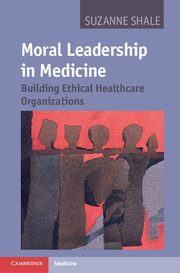Book contents
- Frontmatter
- Contents
- Preface
- Acknowledgements
- Chapter 1 Why medicine needs moral leaders
- Chapter 2 Creating an organizational narrative
- Chapter 3 Understanding normative expectations in medical moral leadership
- Prologue to Chapters 4 and 5
- Chapter 4 Expressing fiduciary, bureaucratic and collegial propriety
- Chapter 5 Expressing inquisitorial and restorative propriety
- Epilogue to Chapters 4 and 5
- Chapter 6 Understanding organizational moral narrative
- Chapter 7 Moral leadership for ethical organizations
- Appendix 1 How the research was done
- Appendix 2 Accountability for clinical performance: individuals and organizations
- Appendix 3 A brief guide to commonly used ethical frameworks
- Index
- References
Chapter 5 - Expressing inquisitorial and restorative propriety
Published online by Cambridge University Press: 05 January 2012
- Frontmatter
- Contents
- Preface
- Acknowledgements
- Chapter 1 Why medicine needs moral leaders
- Chapter 2 Creating an organizational narrative
- Chapter 3 Understanding normative expectations in medical moral leadership
- Prologue to Chapters 4 and 5
- Chapter 4 Expressing fiduciary, bureaucratic and collegial propriety
- Chapter 5 Expressing inquisitorial and restorative propriety
- Epilogue to Chapters 4 and 5
- Chapter 6 Understanding organizational moral narrative
- Chapter 7 Moral leadership for ethical organizations
- Appendix 1 How the research was done
- Appendix 2 Accountability for clinical performance: individuals and organizations
- Appendix 3 A brief guide to commonly used ethical frameworks
- Index
- References
Summary
When medical care goes wrong, what are the moral responsibilities that fall to medical leaders? This chapter is an examination of the proprieties involved in managing medical harm. It is concerned with the moral repair necessitated by tragic mischance, damaging errors, catastrophic omissions, unwanted side effects, organizational dysfunction, management failure, and more [1–3]. Exploring how medical leaders practice propriety to support the restoration of trust in people and organizations, the discussion offers a fresh perspective on medical failure and its place in organizational ethics [4–8].
It is striking to find that the leading texts on healthcare organizational ethics have canvassed scant discussion of medical harm [9–14]. This is surprising for several reasons. Organizational ethics has reasonably been defined as ‘the study of personal and organizational moral norms and choices as they contribute to the activities and goals of an organization and to the integral human fulfilment of persons and communities’ [9(p15)]. Preventing medical harm from occurring, and morally responding to it when it does, would appear to be pivotal to this goal. The worldwide patient safety movement has made preventing and responding to medical harm a fiduciary concern for all doctors, and for medical leaders in particular [15–29]. Along with harm to patients, the financial and human costs for institutions following medical harm are a significant burden, so the topic might be expected to be prominent in institutional ethics. Finally, if a good first principle for medical professional ethics is ‘first do no harm’, a corollary principle might be expected to play a central role in healthcare organizational ethics.
- Type
- Chapter
- Information
- Moral Leadership in MedicineBuilding Ethical Healthcare Organizations, pp. 140 - 183Publisher: Cambridge University PressPrint publication year: 2011



